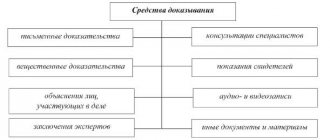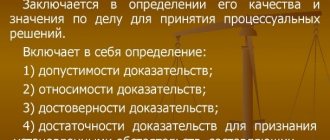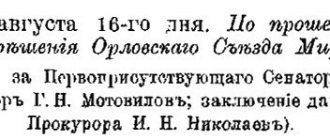Inadmissible evidence in a criminal trial is everything that was obtained in violation of the procedural law (Code of Criminal Procedure of the Russian Federation). This definition is given in Article 75 of the Code of Criminal Procedure of the Russian Federation. It also determines the consequences of declaring evidence inadmissible - a ban on using it to build an accusation and in the process of proving other circumstances related to the commission of a crime.
Assessing the admissibility and inadmissibility of evidence is the competence of the investigation (inquiry) at the stage of investigation of a criminal case and the court at the stage of consideration of a criminal case. The defense has the right to demand an appropriate assessment. This right certainly belongs to the suspect and the accused. Since their interests can be fully represented by legal representatives and lawyers, these procedural persons also have the opportunity to file a corresponding petition.
Categories of Inadmissible Evidence
Article 75 of the Code of Criminal Procedure of the Russian Federation allows any evidence obtained with any violation of the criminal procedure law to be classified as inadmissible. Thus, a violation of the Code of Criminal Procedure of the Russian Federation when obtaining testimony, material evidence listed in Art. 81 of the Code of Criminal Procedure of the Russian Federation, documents, information, expert opinions are the only basis for declaring evidence inadmissible.
Three categories of inadmissible evidence are specifically stipulated:
- Unconfirmed testimony in court of a suspect and accused interrogated as part of a criminal investigation without the participation of a defense attorney, including in cases of voluntary refusal of a defense attorney. If, for example, the accused admitted his guilt during the investigation and did so without his lawyer, and then in court refused to confess, then such testimony will not have any significance.
- Testimony of witnesses and victims, which are based on conjectures, rumors and (or) assumptions, as well as such testimony in which the witness is not able to name the source of information.
- Documents, information, items that are part of a lawyer’s record-keeping and received as part of operational investigations or investigative actions. An exception is tools, means, equipment for committing a crime or with traces of a crime.
All other evidence regarding which the question of inadmissibility arises is assessed individually for compliance with the requirements of the Code of Criminal Procedure of the Russian Federation upon receipt (provision, seizure, etc.).
Sources that may be considered unreliable
It is known that evidence can be material and personal, that is, obtained in the process of linguistic presentation of information. In order for law enforcement agencies to clearly distinguish between slander and rumors, each fact must be verified for accuracy.
Information obtained from the accused himself is considered unreliable, since he may deliberately confuse the investigation in order to delay sentencing and prosecution. Evidence obtained from close relatives of the victim or accused will be unreliable. The fact is that close friends, comrades or relatives can say anything to whiten the reputation of their acquaintance. An unacceptable type of evidence can also be obtained from persons who are not responsible for their actions and words due to a mental disorder or other physical abnormalities of the body that prevent a person from soberly assessing the situation and thinking.
Article 75 of the Code of Criminal Procedure states that it is unacceptable to use materials that come from untrusted sources of information, that is, the information is available, but who spoke and under what circumstances is not known. Evidence coming from a person who does not want to identify his informant is also not taken into account. Information obtained during the interrogation of persons who were not warned of the right not to testify against their loved ones may also be considered inadmissible in legal proceedings.
Separately, I would like to note the process of introducing evidence received from experts. Specialists from a specific industry are often involved in criminal proceedings to obtain some clarification or value judgments on issues. It is impossible to prove the guilt of the subject, sometimes even in the presence of an examination incriminating him of the crime. A judge may recognize an expert’s opinion as inadmissible evidence if:
- he is incompetent in this matter or has a low level of qualifications;
- included his opinion in the research procedure and description of the results;
- previously participated in the case as a consultant and has an interest in the outcome of the case.
At the request of one of the parties, the expert may be removed from conducting an examination or research if the judge considers it justified.
The meaning and characteristics of evidence in criminal proceedings
The procedure for declaring evidence inadmissible is clear to everyone. Even if the evidence displays information important for the investigation or confirms the guilt of a particular subject, it will not be considered in court until it takes on a procedural form. Even documents that are notarized, that is, have legal force in fact, will not be considered as evidence if they are not recorded in the case materials.
What violations lead to inadmissibility of evidence?
Based on the wording of Art. 75 of the Code of Criminal Procedure of the Russian Federation, the nature and extent of the violation of procedural law does not matter.
The violation must concern the procedure for obtaining specific evidence when performing a specific procedural (investigative action):
- Testimony of a victim, witness, suspect, or accused is obtained during the interrogation of a person having a certain procedural status, as well as during an investigative experiment, verification of testimony on the spot or a confrontation. In each case, the interrogation or other form of testimony must proceed in compliance with established requirements. Thus, in particular, an explanation of rights and obligations is mandatory. In some cases, when obtaining testimony, the participation of other persons is required, for example, a teacher, legal representative, translator, defense lawyer. Violation of the requirements of the Code of Criminal Procedure of the Russian Federation when obtaining testimony is grounds for recognizing the testimony as inadmissible evidence. It will also be a violation to interrogate a person who does not actually correspond to the procedural status in which he is interrogated. This basis often includes situations where a suspect is actually interrogated by a witness, although he should be interrogated precisely as a suspect.
- Violations related to obtaining material evidence are often committed. This includes, first of all, objects and documents related to the crime that can help in its detection or establishment of the circumstances of the crime. As a rule, material evidence is obtained (seized) during an inspection of the crime scene, search, seizure, investigative experiment, and less often during other investigative actions. The receipt of material evidence must be checked for compliance with the requirements of the Code of Criminal Procedure established for the investigative (procedural) action in which the evidence was received.
- An expert’s opinion is the most difficult evidence in terms of assessing its admissibility/inadmissibility. Here, sometimes it is necessary to analyze and evaluate the entire process of conducting an examination - from obtaining materials for research and ordering an examination to carrying out the research and preparing a conclusion. In addition, it should be borne in mind that if the evidence submitted for research is considered unacceptable, then the conclusion is automatically called into question regarding admissibility. Other possible grounds for inadmissibility of an expert’s opinion include:
- information calling into question the professional level of the expert, his competence, objectivity, independence and other qualities required for an expert;
- violations of the Code of Criminal Procedure when ordering an examination (making a decision and familiarizing the participants in the process with it);
- violations of the Code of Criminal Procedure and other regulations during the conduct of research, including violations related to expert activities.
- Protocols of investigative and judicial actions. Not many people know that these documents themselves are evidence and must meet certain requirements for drafting and execution. However, violations and mistakes are often made here. Sometimes they forget to put the date or time, or they put it in, but it’s wrong. Often a signature is missing in one place or another. Since many protocols today are printed (filled out) on a computer, technical errors, omissions of columns, leaving old records from previous protocols, etc. cannot be ruled out.
- Results of operational investigative activities (ORA) and operational investigative measures (ORM). It must be said right away that the results of operational investigations and operational investigations are not in themselves evidence in criminal cases and cannot be included just like that. They are not included in the list of evidence in a criminal case, which is determined by Art. 74 Code of Criminal Procedure. Due to the incorrect approaches of investigators and interrogators to the rules for introducing operational and operational activities, a large number of mistakes are made. Moreover, very often it is on the results of such activities that both the prosecution and the entire evidentiary block are based. In order for the results of an operational investigation and operational investigation to receive the status of evidence, they must be:
- checked for legality of receipt within the framework of the relevant ORM;
- examined with the drawing up of a protocol and, if necessary, with the use of technical means and the participation of a specialist (expert);
- examined, if necessary, within the framework of an appropriate examination for authenticity and absence of distortions (damages);
- attached to the case as documents or material evidence - depending on what criteria they meet.
Often, violations of the law are obvious and do not require much effort to identify them. Their main reasons are the low professional level of operational workers, investigators and interrogators, inattention or negligence on their part. But there are also controversial situations. As a rule, disputes flare up where evidence is of particular importance to the case and not everything went smoothly when it was received.
The most frequently questioned are:
- expert opinions;
- results of searches and seizures;
- ORM results;
- a chain of interconnected evidence on which the accusation is based.
Everything about criminal cases
List of significant violations
Inadmissible evidence, selection of materials
| Normative base - Part 3 7 Code of Criminal Procedure violation of the rules of the Code of Criminal Procedure entails the inadmissibility of evidence — 75 Code of Criminal Procedure inadmissible evidence — 235 Code of Criminal Procedure procedure for excluding evidence in a preliminary hearing — clause 9, part 2 389.17 Code of Criminal Procedure inadmissible evidence will result in reversal on appeal - Part 2 50 The Constitution cannot apply evidence obtained in violation of the law. — clause 18 Plenum No. 29, violation of the right to defense entails inadmissibility — P. Plenum No. 51 clarification on the application of the norm, Plenum No. 51 if evidence is received in accordance with - paragraph 16 Plenum No. 19, arguments about inadmissibility are verified in cassation Reversal of sentence due to inadmissibility Justification for the verdict inadmissible evidence ( EXAMPLES of inadmissible evidence Testimony without a lawyer Testimony without a lawyer , refusal of them makes them unacceptable ( Intoxication Indications in condition intoxication, a type of inadmissible evidence Challenging before trial Challenging Admissibility evidence at the pre-trial stage using norm Illustration declaring evidence inadmissible at the cassation stage Procedural violations Minor procedural violations do not entail inadmissibility |
According to clause 3, part 2 of 75 Code of Criminal Procedure
all evidence obtained in violation of the Code of Criminal Procedure is inadmissible. It is almost impossible to list all types of evidence inadmissible on this basis - the list of possible types of violations is too large.
This very general definition is specified in paragraph.
Resolutions of the Plenum of the Supreme Court “On the Court of First Instance” are inadmissible as evidence if:
- when collecting and securing them, there were significant violations of the procedure established by the Code of Criminal Procedure for their collection and securing,
- if the evidence was collected and secured by an improper person or body,
- and if the evidence was obtained as a result of actions not at all established by the Code of Criminal Procedure.
This is also not a very specific definition, which gives rise to rather contradictory verdicts (in one case the evidence was recognized as having been obtained in violation of the Code of Criminal Procedure, but in another, similar case, it was not recognized). In addition, this is not a closed list; the Supreme Court only clarified what, in particular, is meant by evidence obtained in violation of the Code of Criminal Procedure.
Justification of the verdict by inadmissible evidence
Use of inadmissible evidence
in the sentence this is, of course, a violation.
But the fact that evidence is inadmissible does not mean the entire verdict is automatically cancelled. Inadmissible evidence is simply excluded from the verdict. It all depends on the significance of this evidence - if it is key, then its exclusion causes the entire charge to crumble and then the verdict is overturned. And if there is enough other evidence without it, then its exclusion only entails a technical change in the verdict (the mention of this evidence is simply removed from the text, and everything else remains).
So, inadmissible evidence is evidence obtained in violation of the Criminal Procedure Code. It has no legal force, cannot be used as the basis for an accusation and cannot prove anything at all ( Part 1 75 of the Code of Criminal Procedure
). This is the general definition of inadmissible evidence.
| Url Additional information: Significant violations law, a list recognized by practice - justifying the verdict with inadmissible evidence belongs to the category of I). First instance Url Additional information: — Part 1 75 Code of Criminal Procedure unacceptable, this is evidence obtained in violation of the Code of Criminal Procedure — P. Plenum No. 51 violation of the procedure for collecting and securing evidence - in the event that during the preliminary investigation any evidence was obtained during the investigative action in violation of the norms of the Code of Criminal Procedure ( Part 1 75 of the Code of Criminal Procedure ) then the court of first instance may declare it inadmissible ( Url Additional information: The role of the specific evidence in the structure of the evidence base Important: it should be understood that the mere recognition of one of the evidence as inadmissible DOES NOT GUARANTEE the acquittal of the defendant. Read more about this here: The role of the concrete evidence in the structure of the evidence base. ILLUSTRATION Let us give a fragment of a court decision from our practice “ in accordance with Chain of Possessions Chain of legal possessions: violations during the transfer of seized the objects were presented for examination in a bag that was not sealed or sealed.” (Note: This is called breaking the Chain of Law possessions As you can see: the defense managed to exclude one of the pieces of evidence from the evidence base as inadmissible, but this was of no use. Because the role of this evidence is insignificant. II). Appeal Url Additional information: — clause 9, part 2 389.17 inadmissible evidence, grounds for reversal on appeal - in the appeal norm , paragraph 9, part 2 389.17 of the Code of Criminal Procedure the use of inadmissible evidence is indicated as one of the absolute grounds for overturning the verdict. III). Cassation Url Additional information: - paragraph 16 Plenum No. 19 justifying the verdict with inadmissible evidence - in a cassation appeal it is possible to refer to clause 16 Plenum No. 19 “the arguments of the complaint about - on the basis of this paragraph, we have the right to use arguments in the cassation appeal about any violations specified in Article 75 of the Code of Criminal Procedure Url Additional information: Loopholes for appeal facts, opportunities to circumvent the ban - moreover, if at the stage of cassation appeal the defense discovered court errors related to inadmissible evidence, then it becomes possible to bypass the Prohibition of Appeal actual circumstances. Consequences of inadmissibility of evidence Url Additional information: — Part 1 75 Code of Criminal Procedure inadmissible evidence has no legal force A) Inadmissible evidence Url Additional information: — Part 1 75 Code of Criminal Procedure inadmissible evidence is not used in the prosecution b) inadmissible evidence Url Additional information: — Part 1 75 Code of Criminal Procedure Inadmissible cannot prove circumstances from Inadmissible evidence cannot prove the circumstances subject to proof (these are the circumstances specified in |
Here are some examples of what practice understands as unacceptable evidence:
Evidence obtained by an improper person or body
This is when a case is initiated and conducted by a department that is not exactly required by law.
For example
: they opened a case in the usual manner against a specific citizen and began to investigate.
And then it turned out that this was not an ordinary citizen, but a deputy of a local government body (i.e. a special subject
). And for special subjects, their own procedure for initiating a case has been established - it cannot be initiated by an ordinary investigator, a larger boss is needed here (the head of the investigative committee for the subject of the Russian Federation). This means that everything that the investigator “investigated”, everything that he collected, is unacceptable evidence, because he had no authority to do this without special permission. Resolution of the Presidium of the Supreme Court of the Udmurt Republic dated September 28, 2018 N 44у-95/2018.
Such violations include cases of initiation of a case with a violation of investigative jurisdiction (only substantive - 151 Code of Criminal Procedure
, but not territorial –
152 Code of Criminal Procedure
).
Evidence obtained in significant violation of the procedure established by the Code of Criminal Procedure
The Criminal Procedure Code has many procedures for obtaining evidence: any investigative action is such a procedure. Violation of the procedure results in the inadmissibility of the evidence obtained. But, again, the violation must be significant.
For example, the absence of a court decision to search a home ( Part 3 182 of the Code of Criminal Procedure
) is a significant violation of the procedure.
But, let’s give an example when the procedure established by the Code of Criminal Procedure is clearly violated, but the violation is still insignificant (from the point of view of practice).
Example:
195 of the Code of Criminal Procedure
establishes a fairly clear procedure for appointing and conducting a forensic examination - first, the investigator makes a decision to order an examination, then introduces it to the accused, and only after that the examination itself is carried out.
This procedure allows the accused, before the examination takes place, to ask his questions to the expert or challenge him ( clause 11, part 4, 47 of the Code of Criminal Procedure
).
But in reality, what often happens?
The investigator simply at one moment gives the accused both the order for the examination and the examination itself, which has actually already been carried out - go ahead, get acquainted with everything at once... This is an obvious violation of the procedure established by 195 of the Code of Criminal Procedure
, and the Constitutional Court of the Russian Federation has already said many times that this cannot be done (for example, the Constitutional Court’s Ruling of 02/05/2015 No. 259-O).
But, this is a minor
violation, although it is a violation. Because, according to the logic of the law enforcement officer, there is no need to quibble over minor procedural issues; you can ask the expert about your questions in court a little later and ask for a repeat examination. And if they refuse (which is very likely), that’s a completely different story. An example of such logic, not in these words, of course, but in more official language, is the Appeal Ruling of the St. Petersburg City Court dated June 27, 2022 No. 22-5123/17.
You can read more about this type of violation here: Read the resolution
after the examination, the significance of the violation.
Evidence obtained outside the scope of the Code of Criminal Procedure
This violation most often involves the evidence presented by the defense. a specialist’s opinion as an alternative to the conclusion of a forensic examination.
. When the conclusions of a forensic examination seem dubious or simply unprofessional, then the defense makes “its own examination” (procedurally, such evidence is considered a specialist’s conclusion).
It would seem that everything is according to the law, this is a type of evidence ( clause 3.1 part 2 74 of the Code of Criminal Procedure
).
And the rule, part 2.2 159 of the Code of Criminal Procedure,
generally says that the defense cannot be denied the inclusion of a specialist’s opinion (if it is on the merits of the case).
But there are such decisions: “As for the specialist’s conclusion, which the lawyers presented to the appellate court, the judicial panel cannot recognize it as admissible evidence, since the conclusion was obtained in a non-procedural way, that is, in violation of the procedure for the participation of a specialist in criminal proceedings, established 168, 270 of the Code of Criminal Procedure of the Russian Federation.” Appeal ruling of the Moscow City Court dated February 28, 2018 in case No. 10-695/2018.
In other words, it is not the investigator who attaches this expert’s conclusion, explains his rights, etc., but some kind of lawyer, so all this is not within the framework of the Criminal Procedure Code. And such decisions are not at all unique. True, it is worth noting that the Supreme Court sometimes directly criticizes such “tricks”.
For example
: “It is impossible to agree with the conclusion of the court of first instance that the expert’s conclusions should not be taken into account due to the fact that they were “obtained outside the framework of the trial and in violation of the procedure for conducting forensic examinations.” This conclusion contradicts the provisions of Articles 53, 58, 86 of the Code of Criminal Procedure of the Russian Federation, according to which the defense attorney has the right to collect evidence, including by obtaining a specialist’s opinion. He may also ask the court to question a specialist to clarify relevant issues, including those related to his giving an opinion.” Appeal ruling of the Judicial Collegium for Criminal Cases of the Supreme Court of the Russian Federation dated January 24, 2018 N 73-APU17-25.
In this case, the Supreme Court indicated to the lower court that this cannot be done - the Code of Criminal Procedure allows the defense to also obtain a specialist’s opinion. He indicated, but considered that this conclusion still does not solve anything, therefore, in general, everything is correct... the verdict is upheld.
This is all to say that violation of violation is discord. There may be a violation and even recognized as such by the court... but at the same time, it does not really affect anything.
Illegal composition of the court
This violation is directly established by law as significant ( clause 2, part 2 389.17 of the Code of Criminal Procedure
).
The illegal composition of the court is understood not only as some kind of “disorder” with specific judges, but also as a general violation of the rules of jurisdiction ( 31 Code of
). This is logical - an incorrectly defined court means the “incorrectness” of all the judges of that court.
Plenum on appeal ( clause 19
) and the Plenum on Cassation (
clause 20
) also directly say that such a violation is grounds for canceling the verdict and is relevant for any stage of appeal.
At a general level, it is clear that the illegal composition of the court means that the case was considered by the wrong court or judge who should have been by law. By law - this means in compliance with all rules of jurisdiction ( Chapter 5
Code of Criminal Procedure) and in the absence of grounds for disqualification of a particular judge (
63 Code of Criminal Procedure
).
And since the case was considered by the wrong court, then this violates constitutional law - an article of the Constitution (no one can be deprived of the right to have his case considered in the court and by the judge to whose jurisdiction it is assigned by law).
Let us examine what exactly is meant in practice by the illegal composition of the court.
Case studies
Most often, errors occur in the distribution of cases between magistrates and district (city) courts. To each his own - the magistrate cannot consider cases that fall within the jurisdiction of the district court, this is obvious. But the district court cannot take over the case of the magistrate, although he is higher than him in the hierarchy of the judicial system. For example, the sentence was overturned because the case was considered by the city court, but should have been considered by the magistrate (clause 1.5 “Bulletin of judicial practice of the Moscow Regional Court for the third quarter of 2022”).
There is also confusion in the appeal - after all, the appeal can be in different compositions - it can be one judge (single), or there can be three judges, depending on the severity of the crime. And the severity of the crime may change during the process. For example, a person is accused under Part 3 146 of the Criminal Code
(copyright infringement, felony).
In the verdict, the court reduces the severity of the charge to Part 2 146 of the Criminal Code
(and this is already medium severity). And in the appeal, the case is considered by one judge (based on the fact that it is of average severity). But it must be considered by three judges (based on the originally charged gravity, and not the changed one). This is a mistake and this is a reversal of the sentence. Resolution of the Presidium of the Moscow Regional Court dated May 10, 2018 N 192 in case No. 44у-87/2018.
Another error, which again is related to the appeal, is when the appellate court overturns the verdict and sends the case down (to the first instance) for a new trial by a new court. But the new composition turns out to be not entirely new. In this example, the case was returned for review by another judge, but the judge was still the same as the first time. Resolution of the Presidium of the Tambov Regional Court dated 08/02/2018 N 44у-45/2018.
But the most difficult mistake to motivate is the consideration of a case by a judge who has already formed an opinion on the circumstances of this case before its consideration. The simplest cases are indicated in 63 Code of Criminal Procedure
– this is when one judge considers an appeal/cassation/supervisory complaint against his own decision.
How is this possible? For example, the judge passed a verdict, and while all these appeal procedures are going on (forwarding the case, notifying the parties, etc.) he was promoted and became an appellate judge. And his own sentence falls on him. The case is purely theoretical - an error in this form is unlikely.
A more likely case is when the verdict is overturned on appeal, it is returned to the first instance, there it is decided again and again returns to appeal for a new round. And on this second round of appeal it turns out that the same judge who overturned the verdict the first time ( Part 2 63 of the Code of Criminal Procedure
).
Less obvious cases are not when a judge “jumps” up the career ladder or constantly “appears” in different instances in one case, but when he simply made some other procedural decision in the case before passing a verdict.
For example, he chose a preventive measure or returned the case to the prosecutor in accordance with Article 237 of the Code of Criminal Procedure
. And only then he examined the case and passed a verdict.
But this in itself is not a violation - choosing a preventive measure or returning it to the prosecutor does not prevent the same judge from passing a sentence. The main thing is not to evaluate the circumstances of the case based on the merits of the accusation.
For example
, when returning it to the prosecutor, the court indicated that the circumstances of the case indicate that the crime committed was more serious than what was charged in the case (
clause 6, part 1, 237 of the Code of Criminal Procedure
). This means that he expressed his position on the merits of the accusation, which can only be done when passing a sentence. Appeal ruling of the Judicial Collegium for Criminal Cases of the Supreme Court of the Russian Federation dated September 12, 2018 N 19-APU18-15SP.
Another case of violation of impartiality is when one judge judges several accomplices in a crime, but not in one case, but in different cases: one verdict in relation to one accomplice, another verdict in relation to another. In other words, the judge examines the same circumstances of the crime, but issues different sentences. This happens when the case of individual accomplices is separated into separate proceedings. Or they simply first caught and tried one accomplice, and then caught the other. In such a situation, according to the second verdict, the judge will no longer be impartial. He had already concluded for himself earlier that although this second accomplice has not yet been convicted, everything is clear from him (you just need to change the names in the verdict, and the circumstances of the crime have already been established in the first verdict). This is also an example of the illegality of the composition of the court. Resolution of the Presidium of the Vladimir Regional Court dated December 4, 2017 in case No. 44у-81/2017
.
Return to the list of violations
Seek advice
Procedure for excluding evidence from a case
Before the case moves from the investigator to the court, it is necessary to draw up an indictment. This document is the most important, because it is based on the facts described there that a person is held accountable. Quite often, the investigator makes mistakes when drawing up a conclusion, and according to the law, it cannot be allowed for judicial review. You can challenge the conclusion if:
- the facts in its content are replaced by the conclusions of the investigator, but such conclusions are not substantiated or confirmed;
- there is a distortion of information received from witnesses, victims or other participants in the process by introducing new facts and circumstances in the case;
- in the conclusion there are quotes that are purely accusatory. While a person’s guilt is not stated in court, the presumption of innocence applies, and accusing someone of something without reason is a gross violation;
- It is considered a violation if the conclusion contains no evidence in favor of the accused;
- in conclusion, a list of evidence is presented without description. Every piece of evidence, even the smallest one, must have a procedural status and be clearly described; its inclusion in the case must be justified.
If the conclusion is drawn up with errors, it must be contested by filing a corresponding statement addressed to the prosecutor or judge. All data must be verified by a lawyer; this is the only way you can protect yourself from false and unfounded accusations.
To exclude other evidence from the case file that a party considers inadmissible, it is also necessary to file a motion to exclude the evidence. In your appeal to the judge, you must indicate the basis for declaring the evidence incompetent. The court grants or rejects the petition; more often, the facts are excluded from the case. This procedural action is regulated by Art. 235 Code of Criminal Procedure of the Russian Federation. Sometimes, to decide on a motion, a judge may call a witness who is directly related to inadmissible evidence. If the opposing party is not against excluding evidence from the case file, then it is no longer taken into account. If the defense insists on removing evidence, then the prosecutor, as the main prosecutor, will insist on the opposite. If another person involved in the meeting is against the removal or for its removal from the case materials, then he must defend his position independently.
If a case is being tried by a jury, none of the participants in the consideration of the motion to remove evidence should disseminate information about which particular evidence was declared inadmissible, otherwise this will entail undue consequences.
There are precedents in judicial practice when evidence obtained illegally was recognized as admissible, since the defense filed a corresponding petition. Unfortunately, there are still more cases in legal proceedings when inadmissible evidence is not recognized as such and the verdict is based on it. Of course, this is not correct and violates all established norms of law, but for this purpose there is the possibility of filing an appeal against the decisions of the court, which took into account unreliable facts and information.










